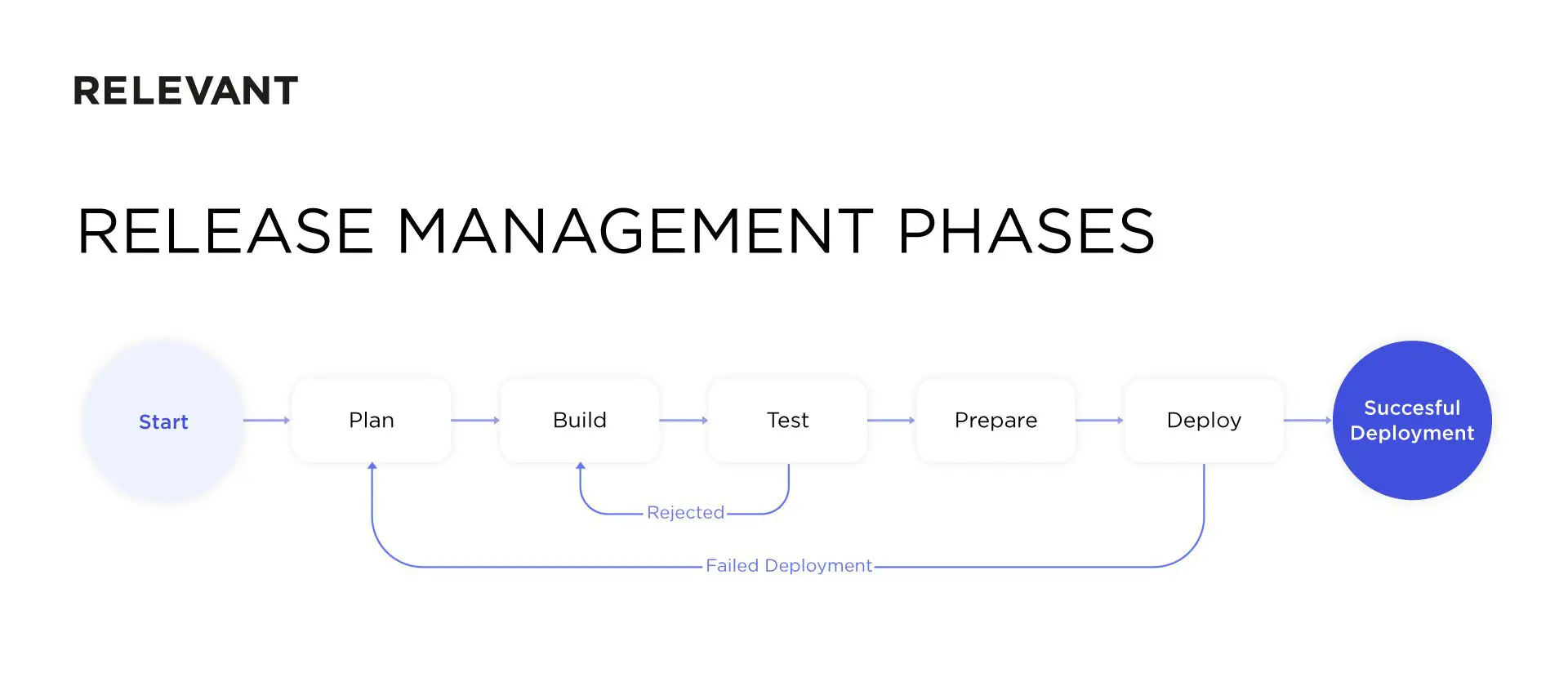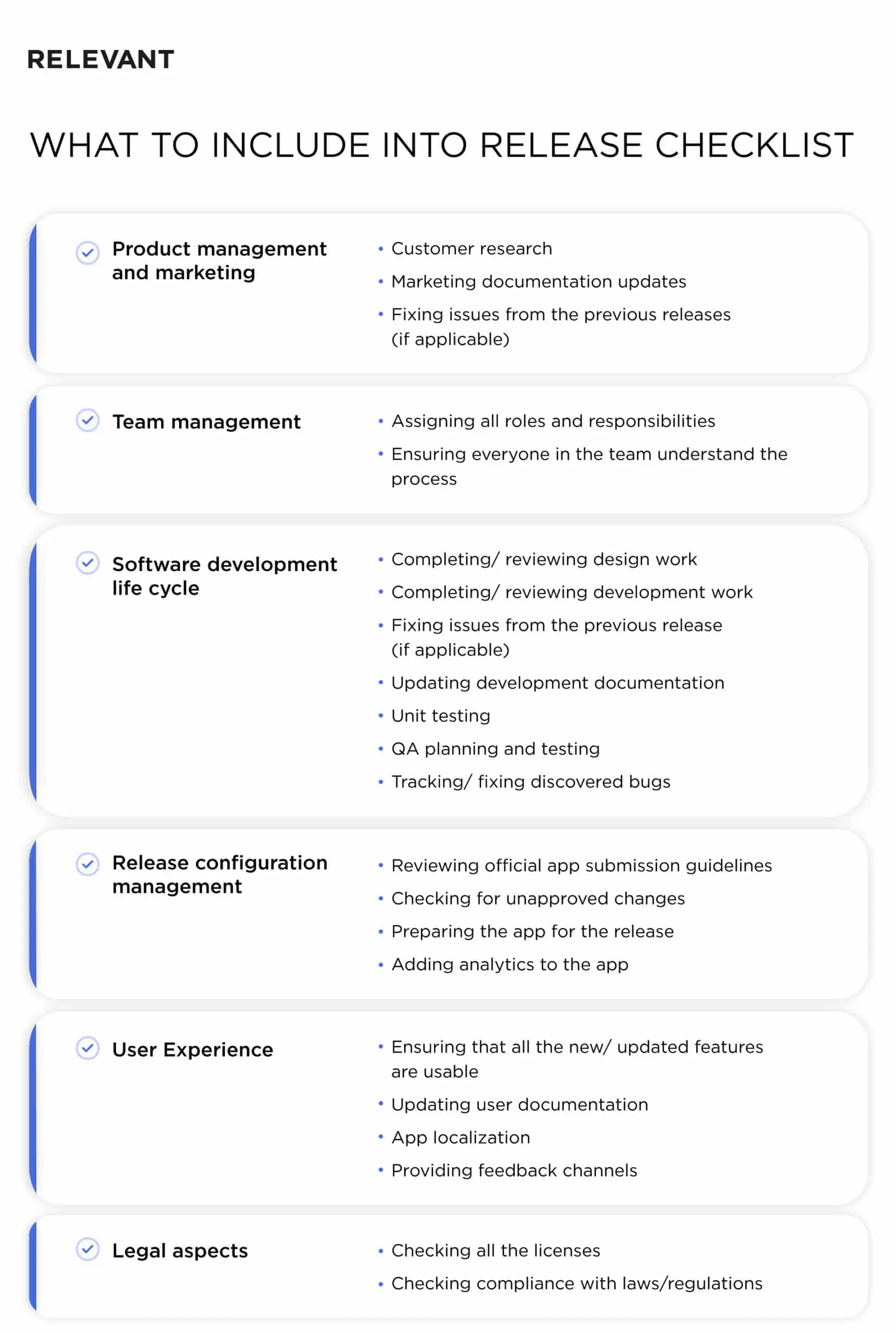Flawless App Releases: Tips to Improve Release Management for Apps

If you’ve ever been in charge of the software release process, you’d agree that effective planning is a must for successful execution. Fail to plan – plan to fail, right? That’s why every software company, no matter how big or small, can significantly benefit from an awesome release management process when all the resources are evaluated, risks managed and steps organized.
Let’s talk about all the whys and hows of the release management process. Keep reading as we’ll guide you through all the planning and organization. We’ll also share some tips as to how you can create a perfect environment for hustle-free release, whether it’s an initial launch or updates to the existing product.
What is release management?
In a nutshell, this is the process of planning, organizing, managing, and controlling software development stages from coding to market launch. Release management happens at the intersection of business planning, IT service management, and software development lifecycle.
You often hear people mention DevOps, CI/CD, Agile development, and automation when talking about release management. We’re going to help you make sense of all that, but let’s start with the basic whys before we move on to the useful hows.
Why do you need it?
In brief, companies need release management to make sure nobody screws up the product update or launch. And even if they do, release management will make it easier to spot the issue and fix it right away. After building more than 200 software solutions (successful and not) for our clients we know how crucial it is.
The greatest benefits of it are:
- more accurate planning and resources distributions;
- more efficient software lifecycle;
- less pressure on tech support due to fewer incidents;
- minimal impact of changes on users;
- better version control.
Release management phases
Here’s what the release management lifecycle looks like. Check out the scheme.

Everything starts with planning, continues with building/testing cycle (until done and working), and ends with deployment. After the latter, the manager captures user feedback and reviews performance targets. If the deployment is successful, the job is done. If not, the team learns the lesson and goes through the whole process all over again.
The role of DevOps in release management
The enterprise-size organizations typically have super-skilled full-time DevOps engineers, whereas smaller companies tend to operate without ones. However, with an established DevOps culture, your team can make every release successful.
The core DevOps principles are called to change and improve the relationship between IT and development so that it’s possible to collaborate better, continuously build and deploy new features, and cut down the time between the release management phases. When building software for our clients we try to implement at least some elements of DevOps for projects of any size.
Release checklist
The release checklist can help you align the work of all teams, from design and development to customer support and sales.
The easiest format for release checklists
Whatever you prefer, Google Spreadsheets or Trello, make three main columns – task, owner, and status.
Tasks
This is where you will write down every single task to be done for the release – software development, communication, legal and financial aspects, customer support, and so on. Don’t assume that some things are obvious because they are not. If it isn’t on the checklist, most likely it won’t be done.
Owner
One thing that often happens when no one is held accountable is a diffusion of responsibility – everyone assumes that someone else is already doing it. So in this column, you’re going to designate the team members responsible for completing those tasks.
Status (to do, in progress, done)
This column is going to help you oversee the process and ensure there are no barriers to accomplishing the job.
What to include into release checklist
Your goal as a release manager is to create a favorable environment for a successful release.
Use the checklist below as a template for your company. It will give you more control over the key release aspects.
Product management and marketing
- Customer research
- Marketing documentation updates
- Fixing issues from the previous releases (if applicable)
Team management
- Assigning all roles and responsibilities
- Ensuring everyone in the team understand the process
Software development life cycle
- Completing/ reviewing design work
- Completing/ reviewing development work
- Fixing issues from the previous release (if applicable)
- Updating development documentation
- Unit testing
- QA planning and testing
- Tracking/ fixing discovered bugs
Release configuration management
- Reviewing official app submission guidelines
- Checking for unapproved changes
- Preparing the app for the release
- Adding analytics to the app
User Experience
- Ensuring that all the new/ updated features are usable
- Updating user documentation
- App localization
- Providing feedback channels
Legal aspects
- Checking all the licenses
- Checking compliance with laws/regulations.
You can modify this checklist to meet the needs of your organization.

What is version control?
Arguably, the hardest aspect of release management is version control. It’s used to keep track of the code changes between updates and be able to revert changes if something goes wrong.
Version control is awesome since it:
- speeds up the development process;
- reduces unintended consequences of human error;
- keeps code history and lets you revert changes at any moment.
- supports integrations with IDE (Integrated Development Environment) tools.
The most popular open-source version control system that can give your team a lot of flexibility is GitHub. Why GitHub? Because it’s easy to learn, easy to use, and super convenient repository for effective collaboration.
The goal of GitHub flow is to:
- Be simple enough to remember.
- Be simple enough to easily follow.
- Ensure CI/CD.
With a solid branching strategy, you can spend less time on managing code and focus more on developing it.

How to create GitHub flow step-by-step
Good news! Things are much simpler than they were in 2010.
Step #1 – Create branches
The Master branch is basically your deployable production code. In other words, it’s your “default” branch, so whenever someone has to fix a bug/ make a feature, they should create a new fully modifiable branch, preferably with some descriptive name. This way, it’s going to be easier for others to understand what happens inside.
Step #2 – Add commits
All the changes within the branch are called Commits. Every time someone makes edits, deletes, or adds a file, they add a “commit” to the branch. Commits create a transparent history so make sure all the commit messages are clear. This way, the team will be able to follow the progress and give feedback.
Step #3 – Review the code in pull requests
Pull Requests are very convenient for discussing the code changes, requesting adjustments, and collecting feedback inside GitHub. Use the @mention system to make communication more effective. Also, you can follow the progress in the unified Pull Request view.
Step #4 – Deploy
After reviewing all pull requests and testing all the branches, move on to deploy your changes for verification in production. GitHub lets you deploy from a branch for final testing in production before merging to master.
Top five useful release management tools besides GitHub
Below are some of the most helpful open-source DevOps tools for optimizing your release management process.
Jenkins
It’s an open-source automation server that helps developers build, test, and deploy their software. Jenkins is one of the most used CI/ CD tools out there. Similarly to GitHub, it integrates with Git source control repositories and helps plan the release, source the code, and keep deployments on schedule.
Docker
Another popular tool is Docker. This is a software packaging and delivery platform that enables you to run, create, and manage software in separate packages on a single operating system. Every so-called “container” is a virtual machine with its own software, libraries, and configuration files.
SaltStack
It’s an effective open-source release management tool used for stabilizing, packaging, configuring, and deploying code. With the help of SaltStack, you can plan the release schedule, manage development branches, coordinate teams, as well as automate testing and deployment.
Ansible
It’s a great tool for configuration management, application deployment, and cloud provisioning. You can use Ansible to shorten and automate the feedback loop during the software development process. You can also integrate it with other DevOps cloud automation tools like Git, Jenkins, and more.
Chef
It’s an open-source CI/CD tool for automating and managing releases in a cloud-native and traditional environment. Chef is extremely useful for compliance and security-related tasks. It can increase the reliability and speed of the apps and infrastructure.
Conclusion
Take the time to carefully plan the release and make use of the best tools and practices to optimize team efficiency. This way, the successful deployment from the get-go is almost guaranteed. And if you want to entrust this to professionals, the best DevOps experts here at Relevant will eagerly help you out. Contact us for more details.



